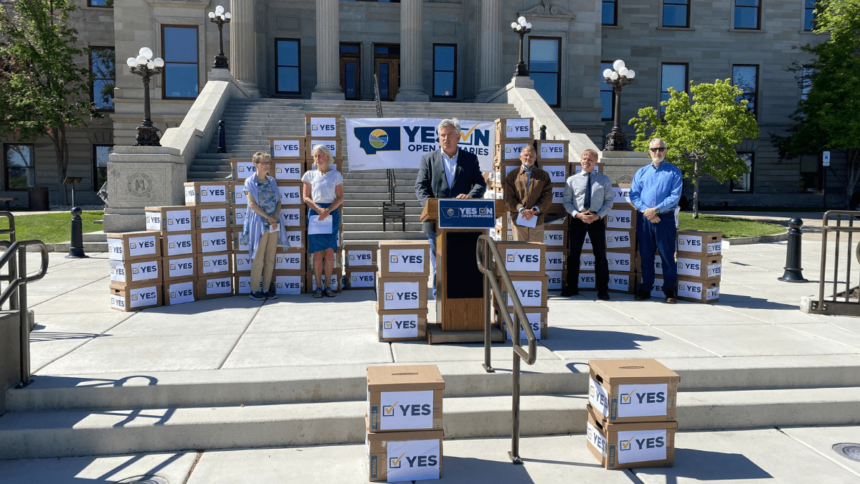Backers advancing a pair of constitutional initiatives that would overhaul how Montana voters elect state and federal candidates said Wednesday that they have collected enough signatures to have the measures placed on the November ballot.
The first initiative, CI-126, would replace Montana’s current party-based June primary elections with a fully open primary that sends the top four vote-getters from a party-agnostic ballot onward to November general elections. The second, CI-127, would specify that candidates must receive at least 50% of the November general election vote in order to be declared a winner, as opposed to the current system where the winner is simply the candidate who receives the most votes.
If formally qualified for the ballot and backed by a majority of Montana voters this fall, CI-127 would also require the state Legislature to pass a law determining what happens in general election contests where no candidate wins an outright majority. Initiative backers say the Legislature could adopt either an Alaska-style ranked-choice voting system or Georgia-style runoff elections.
Speaking at an event organized by the backing committee, Montanans for Election Reform, at the state Capitol Wednesday, former Republican lawmaker Frank Garner argued that the two measures would adjust Montana’s elections to empower independent-minded voters and nudge the state’s politics away from extreme partisanship.
“We know Montanans are fed up with divisive politics, inflammatory rhetoric and an unwillingness to work across the aisle to find solutions to the real challenges facing Montana’s families,” Garner said. “It’s time for a change.”
Garner said Wednesday that the group has collected more than 200,000 signatures for the two initiatives, including support from all 56 Montana counties. In order to qualify constitutional initiatives for the ballot, backers must collect signatures from 10% of Montana’s registered voters, including 10% of voters in at least 40 of the state’s 100 House districts. This year, that equates to a 60,359-signature threshold each of the initiatives must clear.
Because many signatures submitted by initiative backers are either deemed illegible or can’t be verified as matching a registered voter, initiative campaigns generally try to over-collect their target. Signatures are submitted to county election administrators, who review them before forwarding verified signatures to the Montana secretary of state, who makes a formal determination about whether enough have been collected.
Under Montana’s current election system, June primary elections advance a single candidate from each qualified political party to the general election. While primaries are open to all registered voters, voters must pick a single party primary to participate in.
If CI-126, the top-four primary measure, passes, all voters would instead receive an identical primary ballot that would include Republican, Democratic and third-party candidates for each race. Candidates would be able to appear on the ballot without their political party’s endorsement but could, at the Legislature’s discretion, be required to qualify for the ballot by gathering signatures. Voters would cast primary ballots for a single candidate, and the top four candidates would advance regardless of party affiliation.
Similarly, under the current system, the November general election winner is simply the candidate who receives the most votes. That occasionally means candidates are elected with a plurality of the vote rather than an outright majority of 50% or more in races with more than two candidates, as was the case with Sen. Jon Tester’s 2006 and 2012 general election victories.
If the majority vote initiative, CI-127, passes, the Legislature would be tasked with determining what happens if no candidate receives an outright general election majority. Garner said Wednesday that the two likely options would be an Alaska-style ranked-choice voting system or a Georgia-style runoff.
Under Alaska’s system, adopted for general elections in 2020, voters rank candidates instead of casting single votes. If no candidate wins an outright majority based on first-choice votes, vote counters eliminate the worst-performing candidate from the tally and distribute the second-choice votes from that candidate’s supporters to the remaining candidates. If there still isn’t a majority winner, that redistribution process is repeated until there is one.
Under Georgia’s runoff system, an additional election is held featuring only the two candidates who led in the initial vote.
Garner said Wednesday that the majority vote requirement complements the top-four primary model by preventing situations where a multi-candidate race divides the electorate, making it possible for candidates to win power with a relatively small share of the vote.
He pointed to this year’s primary election for Montana’s heavily Republican-leaning eastern congressional district as an example, noting that GOP victor Troy Downing is on a presumably clear path to Congress after winning a plurality in the district’s nine-way Republican primary. Downing advanced on June 4 with 36% of the GOP primary vote, winning about 36,200 votes in a district where 215,700 people cast general election votes in 2022.
Garner also said Wednesday that advancing four candidates to general elections would keep races from being decided in primary elections, which typically see lower voter turnout.
Taken together, Garner argued, the changes would make it more difficult for minority political interests to control Montana’s politics.
“Voters deserve more choice, more competition,” he said.
The Montanans for Election Reform push has drawn support from a coalition of moderate-leaning Montana Republicans and mainstream Democrats. While serving in the state Legislature, Garner was a prominent member of the Republican party’s comparatively moderate Solutions Caucus, as were fellow initiative backers and former lawmakers Rob Cook, Bruce Tutvedt and Bruce Grubbs.
Former Democratic lawmaker Mary Sheehy Moe also spoke in favor of the initiatives at Wednesday’s event.
“The Montana I love cannot survive the ineffective leadership that has been the result of the current primary system,” Moe said.
Montana’s official GOP party apparatus has, however, opposed the top-four primary initiative, calling it a “backdoor” scheme to force the state to adopt ranked-choice voting and arguing the measure would “be destructive to our elections process, cause confusion and disenfranchise Montana voters.”
In a March op-ed column, Montana GOP chair Don “K” Kaltschmidt argued that de-emphasizing party affiliation in primary elections would force voters to do more research and allow candidates to “self-identify as conservatives,” potentially deceiving voters.
“CI-126 proponents claiming to be “Republicans” are being used by out-of-state liberal elites,” Kaltschmidt wrote.
According to financial forms filed with the Montana Commissioner of Political Practices, Montanans for Election Reform has raised $4.2 million and spent $3.4 million backing its initiatives so far. Major contributions to that effort include a nearly $2 million total from Article IV, a national group that says it supports efforts to “give citizens more choice and agency in how their government is run,” and $1.7 million from Unite America, which describes itself as “a philanthropic venture fund that invests in nonpartisan election reform.” The group has also received $362,000 from Action Now, an advocacy group set up by John and Laura Arnold. (Arnold Ventures is also a major donor to Montana Free Press.)
The state’s top election administrator, Montana Secretary of State Christi Jacobson, is also on record as being skeptical of changes to Montana’s election system. In a statement published Wednesday by a regional free-market think tank, Jacobsen expressed explicit opposition to ranked-choice voting and pointed to an ongoing effort to repeal Alaska’s ranked-choice voting system.
“I have serious concerns with the efforts funded with dark money to impose Ranked Choice Voting,” Jacobson said. “It is a very deceptive practice and would undermine all of our efforts to secure our elections in Montana. It would also create serious voter confusion and frustration.”
Garner, though, said the group’s success at signature gathering is evidence of widespread public enthusiasm for reworking how the state’s elections are conducted.
“CI-126 and CI-127 are truly by Montanans, for Montanans,” Garner said. “The response we’ve seen in every Montana county throughout our signature-gathering process proves that Montana voters are ready to see their election system put voters first again.”





